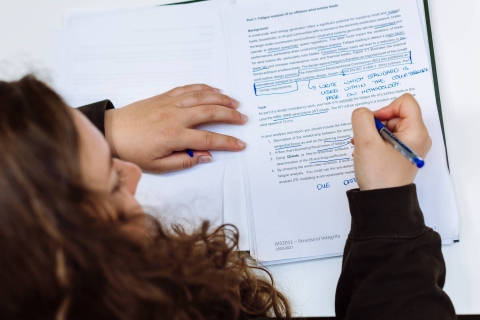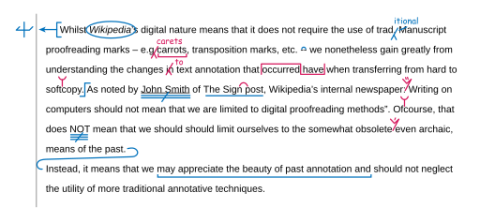
Main navigation - Library
Secondary Menu - Library
Secondary menu
Search suggestions update instantly to match the search query.
The artful editor – all you need to know at this time of the year

by Anne Kathrin-Reck, CCI Faculty
Around Easter time, it is final hand in for a lot of you, from essays to end-of-year reports or dissertations. Now you have done the hard work researching your topic and formulating your arguments, how do you make sure you get the best marks possible?
The final presentation of your work requires you to proof read to ensure it says what you mean. Did you know there is a difference between editing and proof reading? A lot of people mix up editing and proof reading. The latter is the very last stage of the editing process. Let’s shed some light on this.

To start with, you have most likely been given a set of instructions regarding how to present your assignment. These often include word limits (sometimes allowing for +/- 10% variation in length), a required standard of academic language, clear logical order, good standard of spelling, grammar, etc. A number of these points are not quite clear initially. You might have missed that vital session with your Faculty Librarian, Course Tutor induction or someone else. Perhaps it just did not feel all that important back then .
In order to finalise any text, you will have to edit it after you have produced one or more drafts. A definition by thebusinessdictionary.com states the process includes: "arranging, revising, and preparing a written, audio, or video material for final production". Only thing is, at uni you don’t have somebody else doing the work; you are your own editor.
What do you need to be aware of?
Writing (the first draft)
What’s happening when you write your first draft is different from the stage of editing. While firstly, you are creating an initial text, include ideas, present evidence, facts, findings, record something, you also clearly feel closely and emotionally involved in your ‘rough’ product. However, your draft is what it is, unfinished, messy, naïve sometimes. All those feelings are part of the writing process. Even Nelson Mandela or JK Rowling will have written numerous drafts of their eventually successful, meaningful texts.
Re-drafting and editing
Next, you will come to the editing stage. Note, it is a given that it always seems to be much harder to edit & proof read your own text than someone else’s. The sayings ‘you will need to sleep on it’ or look at it ‘with fresh eyes’ were never more relevant. Watch Martin Scorsese work with his editor on his films:
If you want to produce an improved presentable written text, you will need to be aware that:
- editing is an intellectual task of raising the standard of a text
- you need to critique what you have written so far (and whether it matches the set task)
- you revise/ add/ remove/ improve
- you need to ‘zoom out’, get a distance to your original ideas, and try to become objective.

As mentioned in the title, editing is an art and needs to be learned and practised. You will typically focus on:
- the overall logical structure
- your match with stated title / brief / research question
- appropriateness of content under each heading
- signposting and linking content
- length of sentences (check sentences that seem too long as well as fragments)
- your tenses – what makes sense overall?
- use of active vs. passive voice: I have edited this text. vs This text was edited (by me).
It makes often sense to print out your text or parts of it rather than endlessly scrolling up and down on a screen. If you are not sure about how something sounds or flows, read it out aloud or show it to someone else (a critical friend). From experience, what happens often is that you need to identify and reduce repetitions in your text. How well do you know yourself? Which words/ phrases do you overuse? [Ctrl + F ] to search for text within a document is a lifeline.
Proof reading
The very last stage then is called proof reading. Create your own tick list for things to check here like spelling errors/ singular - plural mix-ups, duplicated words, faulty abbreviations, missing or misplaced apostrophes, leaving a full reference inside the text/ final formatting like page numbers, sections, table and figures, and more.
Phew! Not an easy task then, but well worth your effort on your way to a better mark!
To finish off, here are some take-away questions for you to ask (in any order):
- Are my paragraphs too long or too short?
- Are my sentences clearly structured and varied in length?
- Have I checked the spelling?
- Have I checked the grammar?
- Are there page numbers, if needed?
- If there are headings and sub-headings, are these consistently used?
- Have I kept to the word limit?
- Have I used an 'academic style' appropriate for my subject/the topic at hand
- Have I made helpful links between sections?
- Have I used the required reference style correctly?
Click here for even more questions to ask yourself!
P.S. Should I have edited the above differently? Did it need more proof reading? Any comments?
Image credit
Isochrone, CC BY-SA 4.0 <https://creativecommons.org/licenses/by-sa/4.0>, via Wikimedia Commons

